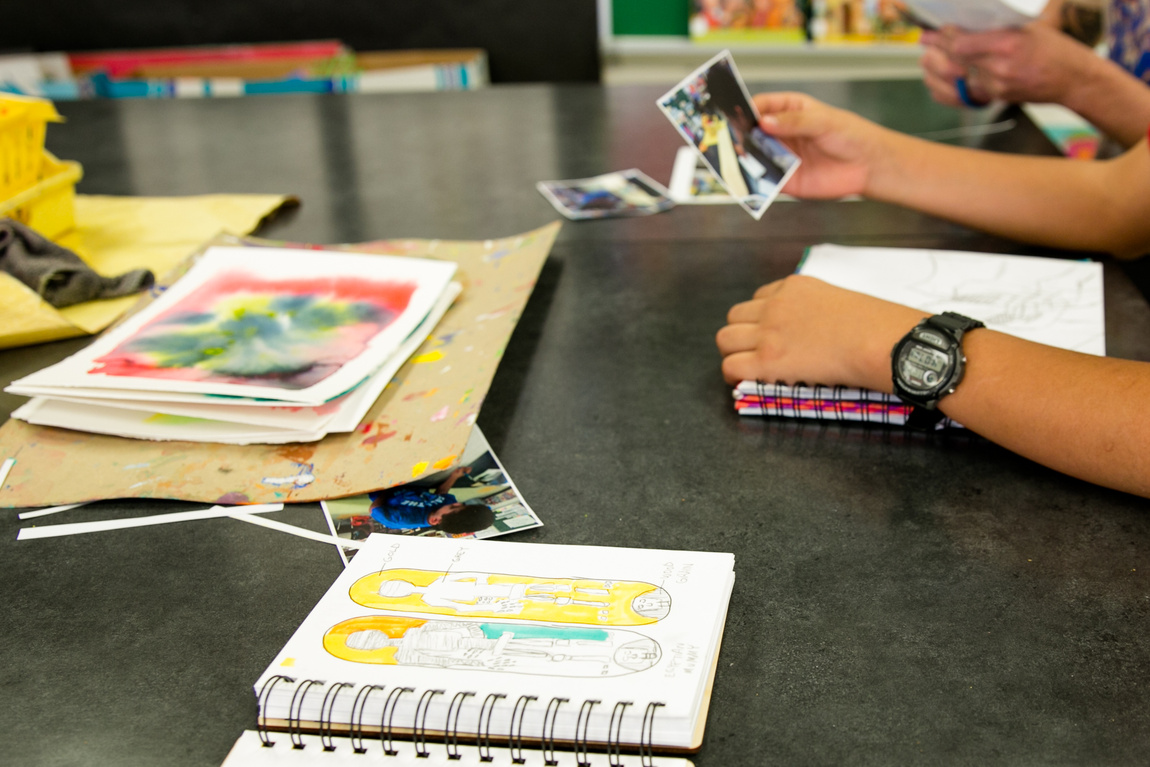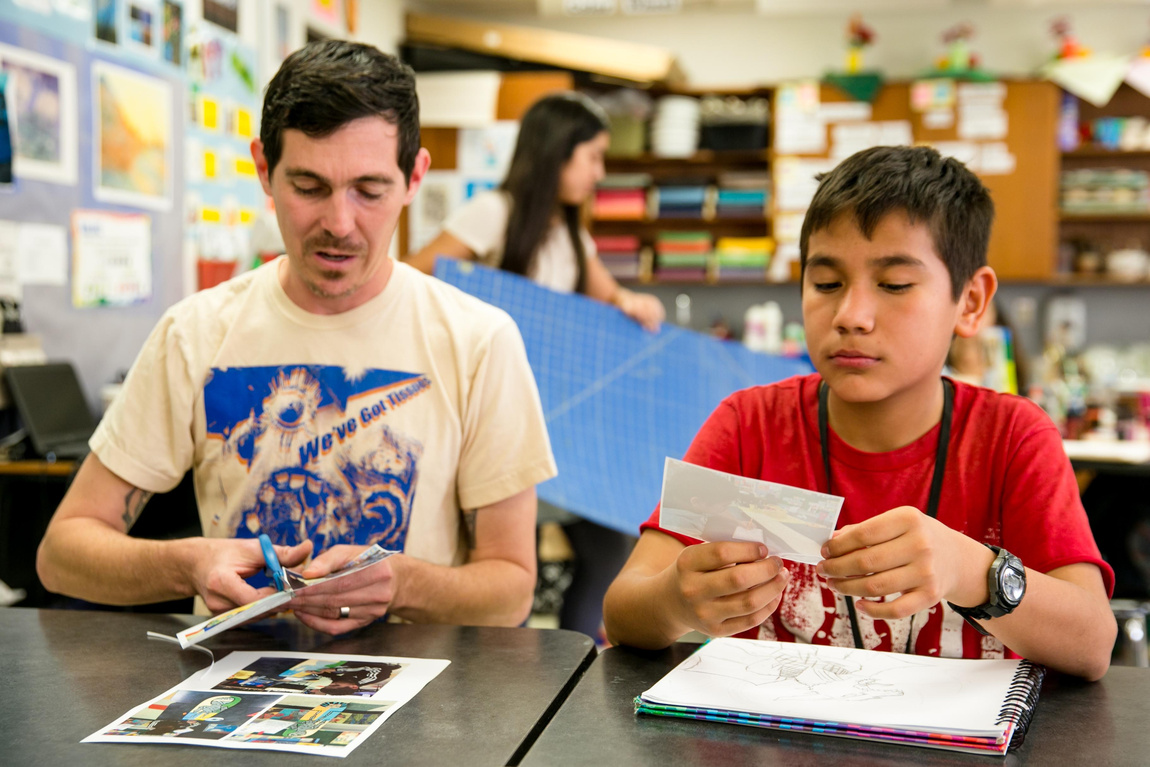By Lisa Wyatt Roe
Think about it: Why would busy professional artists invest the time to go to an art classroom or open their studios for a child they don’t know? And where do they even start if they’ve never been a mentor?
Big Artist Michael Sieben is pretty much the definition of “busy.” As an artist, writer, and skateboard designer, he’s built a creative career over the past 20 years with an impressive amount of initiative. When he couldn’t find a gallery to exhibit his work, Michael and some friends opened their own galleries, including Austin’s Okay Mountain. After years of designing skateboards, he’s started two skateboard companies; his current company is The Program. His illustrations have been in books, on Adidas shoes, on t-shirts, even on TV’s Nicktoons. He’s managing editor of Thrasher Magazine, which has more Instagram followers than the population of several countries. He has two young kids. And he skateboards — a lot. So, yeah, he’s busy.
This year, he took another gig: working as a Big Artist mentor with Little Artist Elias at East Austin’s Blackshear Elementary.
Michael’s path to becoming a Big Artist has roots in a commitment he made in his 20s. Fresh out of UT’s art school, he emailed 20 artists he looked up to for advice on how to start his career. He got one reply. That one artist taking five minutes to respond made such an impression that Michael decided he would share information with younger artists whenever he could.
“I remember thinking in my early 20s that I would never be someone who would ignore someone with questions,” Michael says.
Being an artist who’s part of the ever-youthful skateboarding subculture has given him lots of opportunities to hold true to that, especially with young artists who work in that style. Now in his 40s, he still answers emails. He also gives advice in his column for art and culture magazine Juxtapoz.
Reflecting on how his children are growing up more fortunate than other kids got him thinking about helping in a different way. It was a chance meeting in a parking lot that led Michael to the Little Artist BIG ARTIST program. While saying hello to Chula League board member Brian David Johnson, a two-year veteran Big Artist who teaches woodworking at his BDJ Craft Works studio, Michael got the same kind of gentle nudge toward becoming a mentor that Big Artists give to kids who want to become artists.
“It seemed like a great opportunity to put my time where my mouth was in terms of not just writing about sharing information but actually one-on-one hanging out with a kid and spending time in the classroom,“ Michael says.
As a first-year Big Artist, Michael had a few things to figure out, including what to work on with Elias. For Michael and Elias, their mutual love of drawing was a starting point.
“It was really great to be paired with a young artist who’s really interested in drawing in the same way that, at that age, I was just obsessed with drawing,” Michael says.
When it was time to choose two projects to work on, Michael’s studio full of skateboard decks and screen printing supplies made for a natural choice. “I thought, take the two things I know most about and try to make lesson plans out of those, but also try to explain how that ties into the bigger world of art or graphic design,” Michael says.
Elias and Michael started by working on a design for a skateboard deck in Elias’ journal. They came up with a color palette, then Elias hand painted the deck. “He was able to build up the colors, then do the line work based on his drawing in the sketchbook,” Michael says.
Designing skateboards is a definite niche. “You’re working with something that’s 8 inches by 32 inches,” Michael says. “It’s a very specific shape, so there’s a design problem there — ‘How do I make a design that fits well in this shape?’ — which can carry over into designing anything: an album cover, something square, a t-shirt design.”
The second project was screen printing based on one of Elias’ illustrations. “We did these really loose watercolor paintings,” Michael says. “It was just a very fun experiment of throwing down color on the page. Later we took those and screen printed on top of them, so we were able to lay an illustration down on top of these really loose color fields, and he got to see how that changed the look of his illustration.”
They did a six-print edition so Elias could donate one print to the Little Artist BIG ARTIST auction at the Cherrywood Art Fair, which will send the proceeds to Blackshear’s art program. He has another five that he can give to family or friends, trade, or sell.
That emphasis on the commercial aspect of art — making art that people will want to buy — is an important part of Little Artist BIG ARTIST. One goal of the program is to show kids that art can be a viable career. Michael took that to heart.
“When I was younger, I remember trying to exhibit black-and-white work and showing drawings, and nobody would buy them. And I started adding color into them, and I was able to sell my work. So I think people respond to color,” Michael says. Elias “mainly works in black and white, so I tried to show him some easy ways to inject color into what he’s doing, so if later he does present his stuff to galleries or if he’s trying to sell work, there’s color.”
Big Artists try to walk the line between suggesting a direction for the work and making sure it’s about what the Little Artist wants to express.
“That was a good deal of what we talked about — how to keep the essence of what he’s interested in, which is doing black-and-white work, but easy ways to inject color into it where it doesn’t feel forced or it’s not making him do something he’s not interested in doing,” Michael says.
They also talked about riding bikes, skateboarding, fishing — just whatever came to mind. That kind of one-one-one attention from an adult mentor tells a child, “You’re important.” The adults, however, may never know how important they’ve been to the child. ”It could be something you never get the feedback for, and that’s fine,” Michael says.
It took a bit of time for Michael to feel like he and Elias were connecting. Elias is a quiet, reserved kid, Michael says. But photos of them working together show a thoughtful young artist, quietly taking in what Michael is saying.
“Two weeks ago, he came to my studio, and that was the first time we’d been out of the classroom, and he got to bring his little brother,” Michael says. “It seemed like a less formal setting, and it seemed like he really started to open up. It seemed like the first time we were just hanging out as more like friends rather than teacher or student.”
Something Elias wrote in his journal bears that out: “I think that my artist was more like a friend by the end of the classes. I hope my artist keeps doing Little Artist Big Artist. It was the best thing ever.”
Seeing that on the page was an emotional moment for Michael.
“He just wrote it, closed the book and put it in his pile,” Michael says. “Then he started talking to a friend, and I opened it up and read it. It’s been a meaningful experience for both of us, but I didn’t know if it was just another day to him or if he was getting something out of it. And to read that was really . . . I almost cried.”
For any mentor, a tear or two can be the best part.


